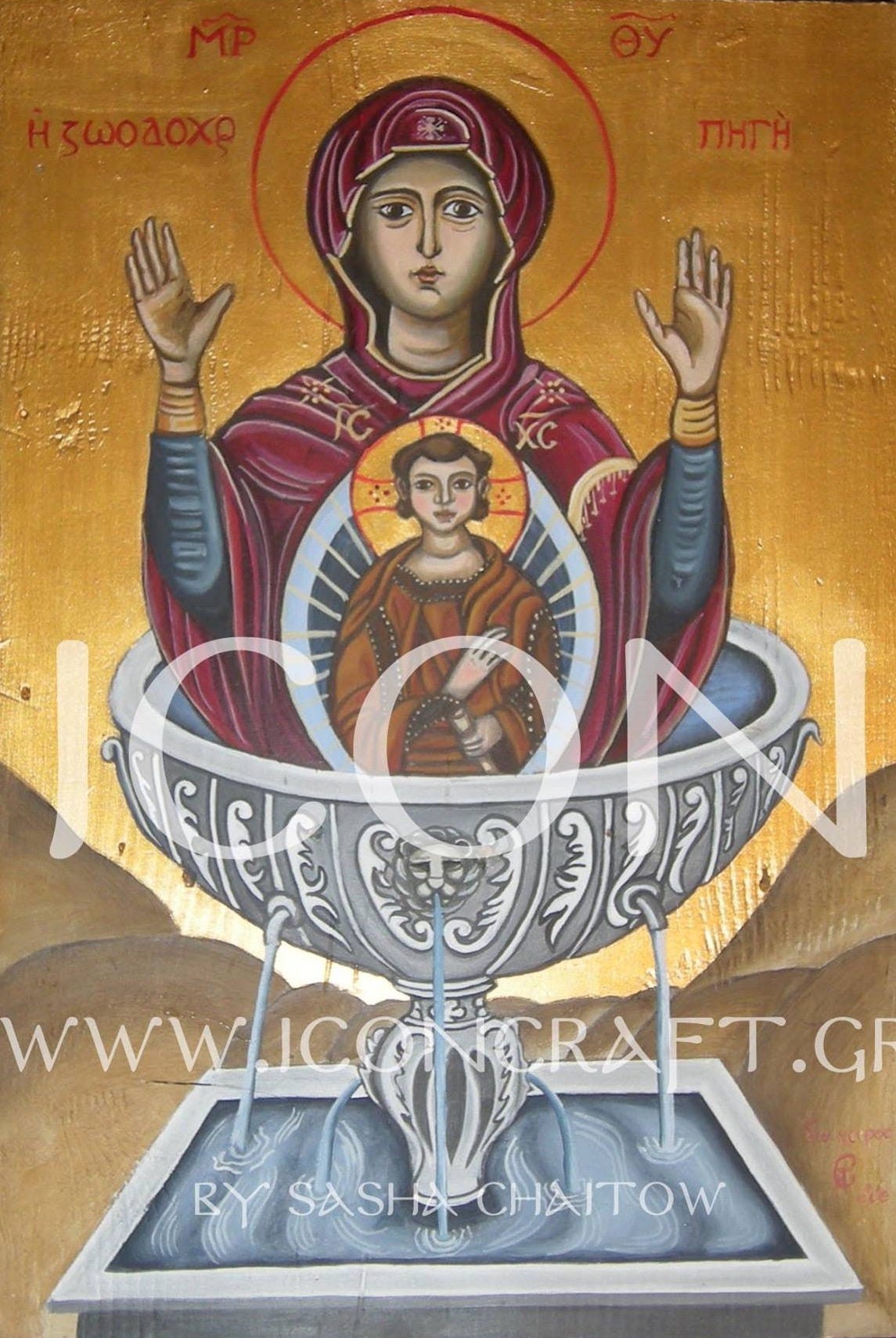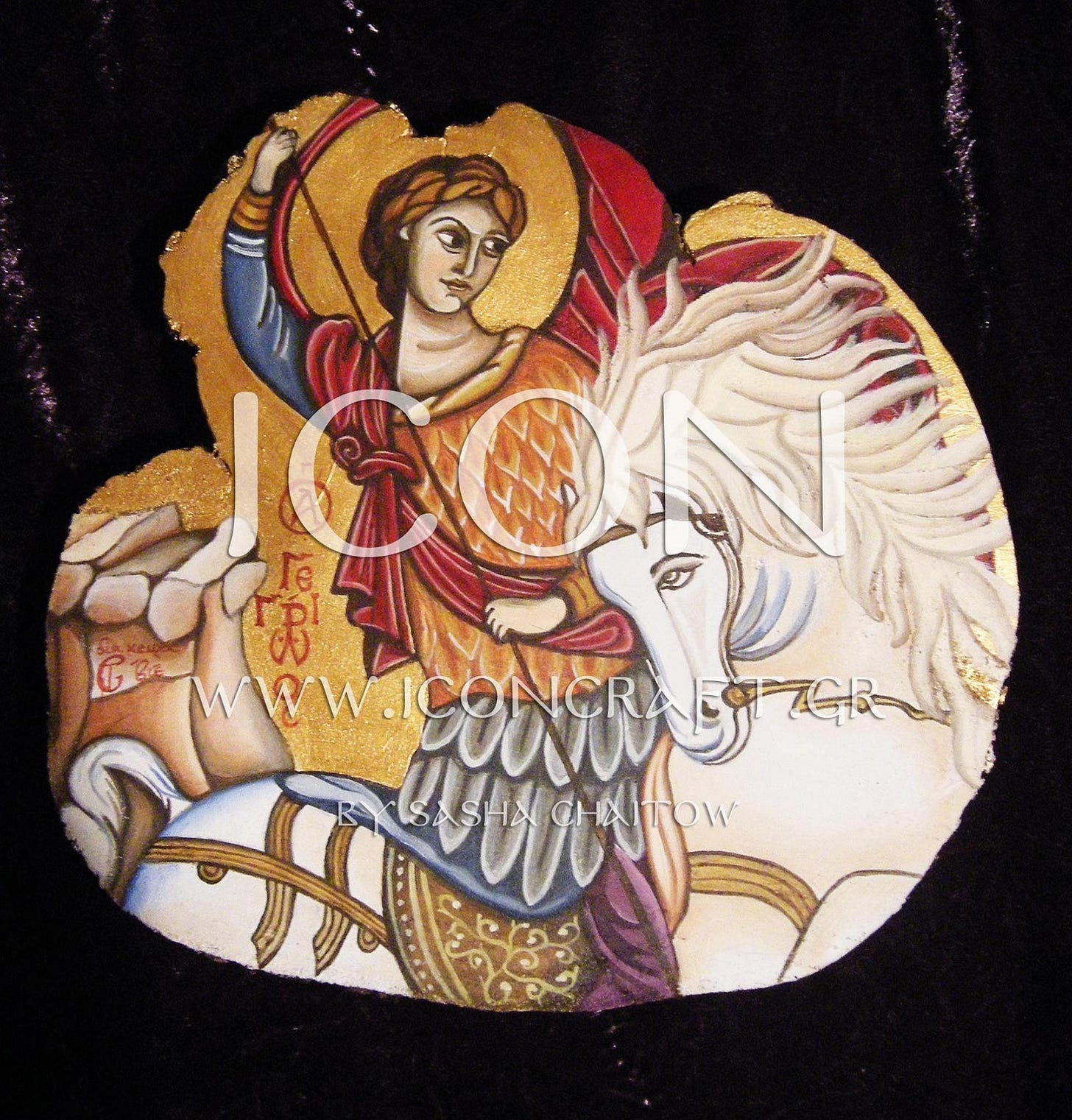God Writes Man as an Icon of the Logos
Why Neoplatonist theology is the cornerstone of Orthodoxy - and why icons are written, not painted.
Please note that as a long read, not all of this post will show up in your inbox. Just click on the “read more” link at the bottom to see the full post, or click here to view the full post in your browser.
I recently read a Substack note linking to an article claiming that some modern iconographers view the English term “icon-writing” as pedantic and incorrect, favouring “painting” and hoping for the phrase to be rapidly “expunged.”
Their argument hinges on Russian and Greek etymology, where the word for “painting” incorporates the sense “to write,” a nuance lost in English.
The writer repeats - almost verbatim - a poorly constructed and unreferenced article from another page, to claim that:
The reasons given for this mistaken usage among icon enthusiasts are the linguistic equivalent of an urban legend… not only does the expression do violence to English and sound just plain silly, but it can introduce notions without basis in the Greek texts — such as, that an icon is essentially a representation of words, as opposed to a representation of things that words represent.
Unfortunately, in making this claim, it is this writer who has introduced notions without basis. The Greek texts are clear and they follow below.
They adorn the article with this little beauty:
A further piece from a different author claims that the term “icon-writing” is modern:
Furthermore, the notion that iconographers "write" rather than "paint" their works is a contemporary idiom with no basis in tradition.
Some modern Greek and Cypriot iconographers also claim the term can only be traced as far back as 20th century iconographer and novelist Fotis Kontoglou, who revived the iconographic tradition after a period of stagnation. The author adds that the Greeks did not iterate a theology of icons until Russian intellectuals did so in the 20th century, and the Russian style is the most prevalent, including within Greek churches.1
These claims are unhistorical, incorrect, and demonstrate a shocking ignorance of Orthodox icon theology (and of Greek Orthodox reality).
The use of the contested term specifically matters due to theological reasons for “writing” icons, rooted in centuries of theological canon, though the writers quoted above all seem to be unaware of it. That canon comprises a comprehensive icon theology which is the bedrock of Orthodox theology and soteriology.
Claims of this nature, and especially the last one, derive from a Russian claim to being the “true heir” to Byzantium, echoing Roman Catholic narratives that resulted in the 1054 Schism2 and 1204 Crusade that sacked Constantinople, feeding the Western narrative of Greek demise for the best part of the last 900 years (no, that is not a typo - see footnote).3
I have no desire whatsoever to bring politics to Thyrathen, but I object strongly to the misrepresentation of Greek and Byzantine history and culture. It spreads misinformation, serving other agendas. It fosters hostility toward Greeks and scholars like myself, and ignores cultural sensitivity.
This response piece focuses on the theology of icons, their Neoplatonic roots, the early development and transmission of icon theology, and why they are “written.” The above claims are conclusively refuted by the textual and theological evidence, provided in detail below.
Next week, I’ll explore the transition from Neoplatonic statue animation to icon animation, revealing consecration and invocation rituals from late antiquity practiced to this day.
Thank you all for your support and encouragement, and a special welcome to new subscribers! As before, free subscribers get a lengthy preview and summary of the piece, while paid subscribers can access the full article.
God Writes the Logos in Man
In Greek, the word term γραφείν (grafein, to write, pronounced GRAF-fin) originally meant to “scratch” or carve, but was later used for writing, drawing, branding, engraving, inscribing, and all forms of mark-making.4
Logos means both speech, and manifestation. In theology it also refers to Christ incarnate as a manifestation of the will of God; an image of divine thought. An image, or icon, is the intelligible form of logos. It is laid down in matter, from speech to image, by the act of grafein; ie.writing.
Both grafein and logos are acts of depicting the spoken word. Not the objects they describe, because divine personages are not objects. The act is a transition from the ineffable to the intelligible precisely reflecting the divine hierarchy. More on that below.
We have this example from St Basileios of Caesarea (4th century), whose ideas strongly impact later doctrine:
Ἐρεύνα τὴν διάνοιαν τοῦ ῥήματος. Διὰ τί Λόγος; Ἵνα δειχθῇ͵ ὅτι ἐκ τοῦ νοῦ προῆλθε… Διὰ τί Λόγος; Ὅτι εἰκὼν τοῦ γεννήσαντος͵ ὅλον ἐν ἑαυτῷ δεικνὺς τὸν γεννήσαντα͵ οὐδὲν ἐκεῖθεν ἀπομερίσας καὶ τέλειος ὑπάρχων καθ΄ ἑαυτόν· ὡς καὶ ὁ ἡμέτερος λόγος ὅλην ἡμῶν ἀπεικονίζει τὴν ἔννοιαν. Ἃ γὰρ κατὰ καρδίαν ἐνενοήσαμεν͵ ταῦτα τῷ ῥήματι προηνέγκαμεν καὶ ἔστι τοῦ ἐν τῇ καρδίᾳ νοήματος ἀπεικόνισμα τὸ λαλούμενον.
Investigate the meaning of the word. Why "Logos"? So that it may be shown that it proceeded from the mind… Why "Logos"? Because it is the image of the one who generated it, showing the whole generator in itself, having separated nothing from there and being perfect in itself—just as our word depicts our entire thought. For what we have conceived in our heart, we have brought forth with the word, and the spoken word is an image of the thought in the heart. 5
So in Greek, and certainly in the theological context, writing is the depiction of both logos (ordinary thought and word) and Divine Logos. We’re not talking about Scripture, but the manifestation of Being and Divine Will. As Christ is the divine Logos made manifest, the icon is the logos of what it depicts.
Grafein on the other hand, becomes a compound to form more distinctive definitions, giving us ζωγραφία/ζωγραφίζω (zografía) meaning to depict from life, or naturalistic depiction.
Thence we get eikonografia, εἰκονογραφία), with the prefix eikon (εἰκών, image), meaning to inscribe a likeness, and αγιογραφία (hagiografia), meaning a description of the sacred, whence hagiography. The latter term is limited to describing written text in English, but in Greek it can refer both to an icon or a vita. These are not late uses of these derivatives; they are Hellenistic,6 (3rd century BCE onwards).
A γραφεύς (grafevs) is both a scribe and an iconographer; the distinction is always in the context. In the theological context, the word is frequently used to describe God as a divine craftsman “inscribing the Logos in man.”
Painting, as opposed to icon-writing, is defined as a technical activity: χρωματουργία (chromatourgia, lit. colour-work). This distinction is made explicitly in the 1791 Orthodox canon drawing on 4th century sources:
Εἰκὼν λέγεται ἀπὸ τοῦ ἔοικεναι, ἤτοι ἀπὸ τὴν ὁμοιότητα ἣν ἔχει πρὸς τὸ πρωτότυπον. Καὶ ἄλλη μὲν λέγεται φυσικὴ, καθὼς ἔστιν ἕκαστος φυσικὸς υἱὸς πρὸς τὸν φυσικὸν πατέρα αὐτοῦ (ὅπερ καὶ ὁ θεῖος Βασίλειος, τὸ, ἡ τιμὴ τῆς εἰκόνος, ἀνωτέρω ῥηθέν, ἐπὶ τῆς φυσικῆς εἰκόνος ἐξέλαβε τοῦ Υἱοῦ καὶ Λόγου πρὸς τὸν Θεὸν καὶ Πατέρα). Ἄλλη δὲ μιμητικὴ καὶ τεχνικὴ, καθὼς ἔστιν ἡ διὰ χρωματουργίας γινομένη, καὶ ἄλλης ἐπιτηδείου ὕλης…
An icon is so called from its resemblance, that is, from the likeness it has to the prototype. One type is called natural, as every natural son is to his natural father (which the divine Basileios also understood, when he said above, “the honour of the icon,” referring to the natural icon of the Son and Word in relation to God and the Father). Another type is mimetic and technical, as is that which is made through painting or other suitable material...7
Thus, we say that icons are written, and not painted, because, beginning with John 1:1, their creation is considered a scribal act, their content divine likeness like that of a son resembling a father and a father begetting a son, their nature that of sacred inscription, their veneration an act of reading as well as communion for the purpose of theosis.
This understanding of logos, eikon, and the depiction of divine persons by means of symbols central to icon theology is extensively developed in pseudo-Dionysios; the pivot between the Neoplatonists, Cappadocians, and foundational Orthodox doctrine.8

Pre-Christian concepts of sacred writing/inscribing
Greek, Egyptian, and Jewish traditions all shaped sacred writing and inscription in worship. Hieroglyphs, unlike linear writing, are phonetic symbols, ideograms, pictograms, and mythograms;9 their meaning shifting with context and mythic references (explored in my upcoming book on Horapollon’s Hieroglyphica).
A product of the rich fusion of Greek and Egyptian culture, the Fayyum mummy portraits (1st-3rd centuries), were inscribed with sacred texts alongside the naturalistic portraiture that prefigures icons. They are a wonderful representation of the syncretism between Egyptian beliefs surrounding the afterlife, Greek use of two-dimensional images as vessels for the soul, and the inscription of sacred hieroglyphs as part of funeral practice in a transitional era. They are also pivotal to the transition from the sacred statue and the portable two-dimensional image.10
Up until the 4th-5th centuries, early Christians used Hellenistic pagan iconography for scriptural scenes, borrowing Egyptian narrative registers, sacred inscriptions, and mythographic depictions. Greek traditions contributed the concept of personification, motifs, symbolism and epithets. Thus familiar figures were repurposed; the figure of Orpheus most commonly used to depict Christ; the Mother goddesses variously used for Panagia, and so forth.

Pagan rituals continued despite persecution; I have written on this extensively elsewhere.
These early centuries were a period of intense theological debate on many fronts, multiple groups conflicting over elements of doctrine, from the nature of God and Christ to the doctrine of generation.
Among the matters of concern were icons: where Jewish input cast suspicion on icons, Scriptural justification was found for them. Meanwhile, worshippers went on doing what they knew - the folk traditions I have presented thus far stand testament to the force of habit and tradition.
In the fifth century, ps.-Dionysios’ lengthy, poetic treatises harmonised multiple aspects of Christian doctrine and liturgy with a solid Neoplatonic foundation.11 He says much on the role of icons as intermediaries to theosis, but one of the most telling passages is as follows:
Keep reading with a 7-day free trial
Subscribe to Thyrathen: Greek Magic, Myth, and Folklore to keep reading this post and get 7 days of free access to the full post archives.







